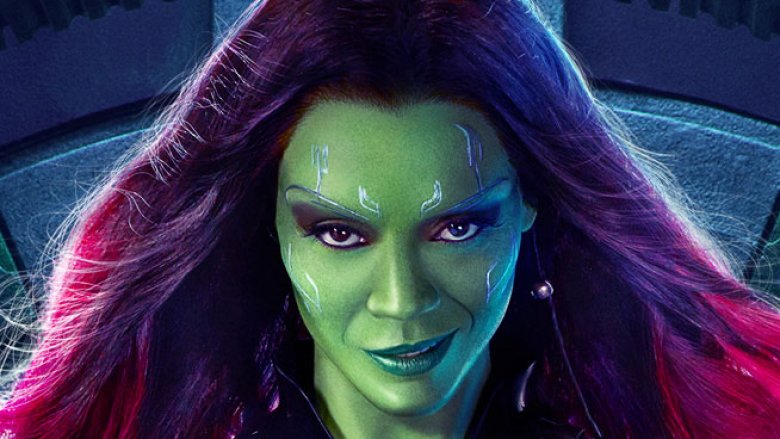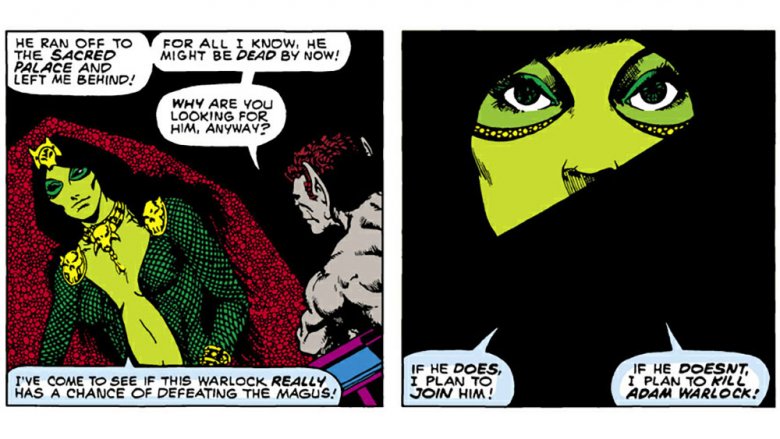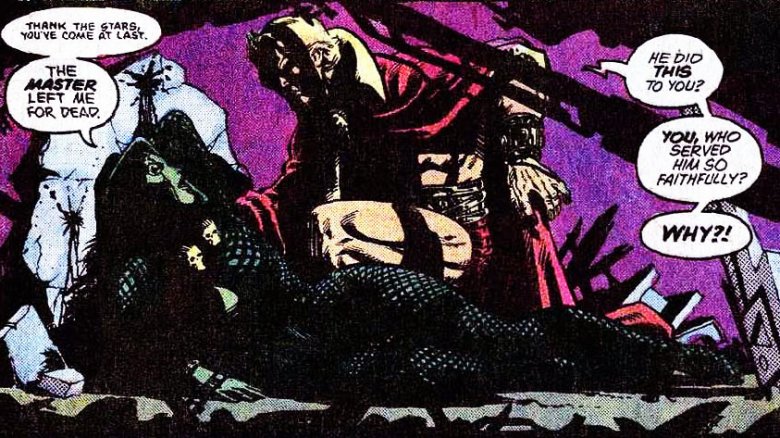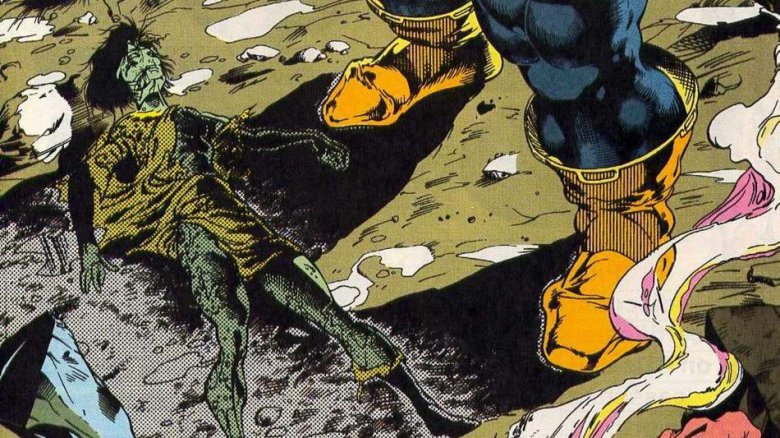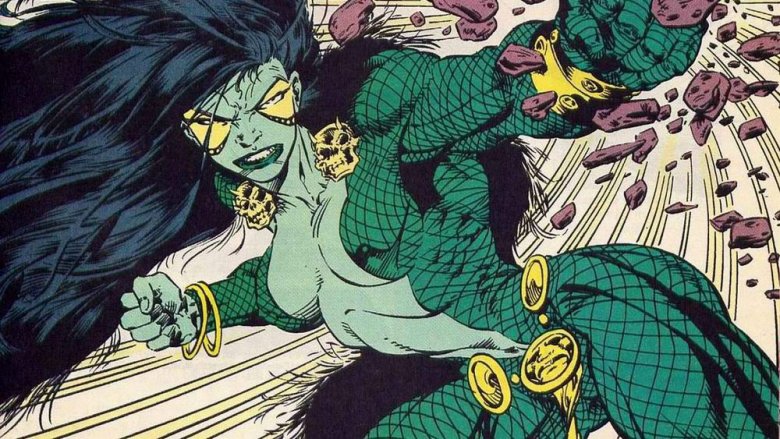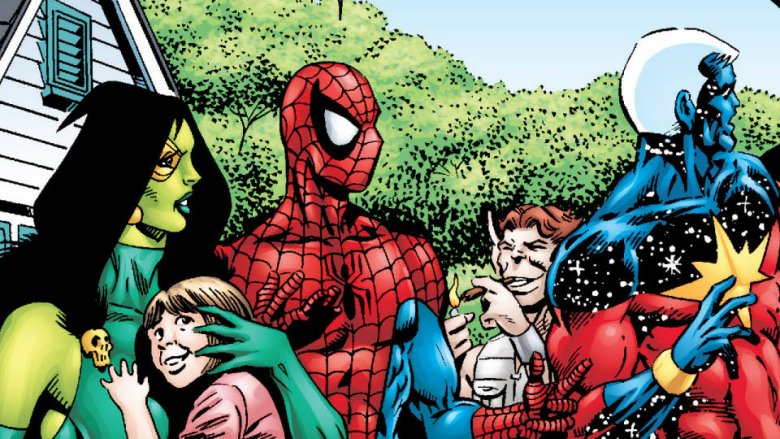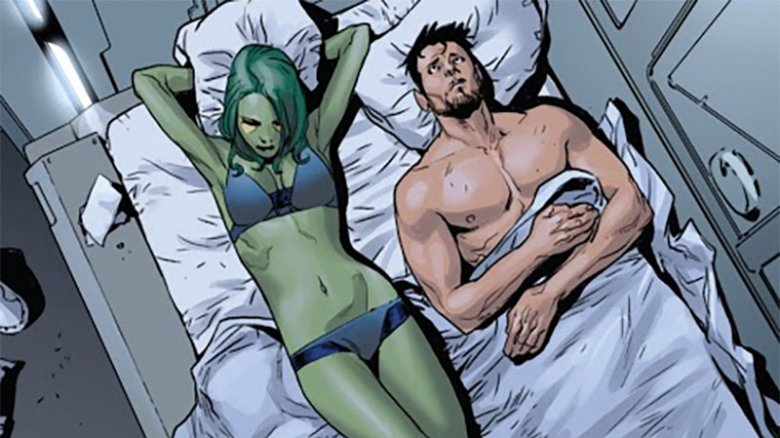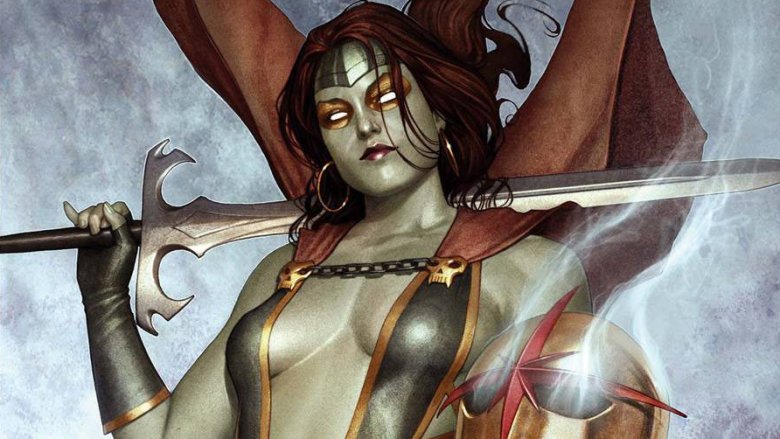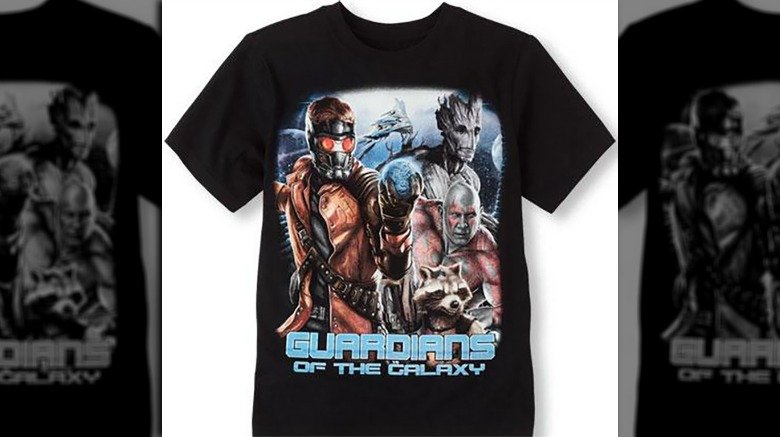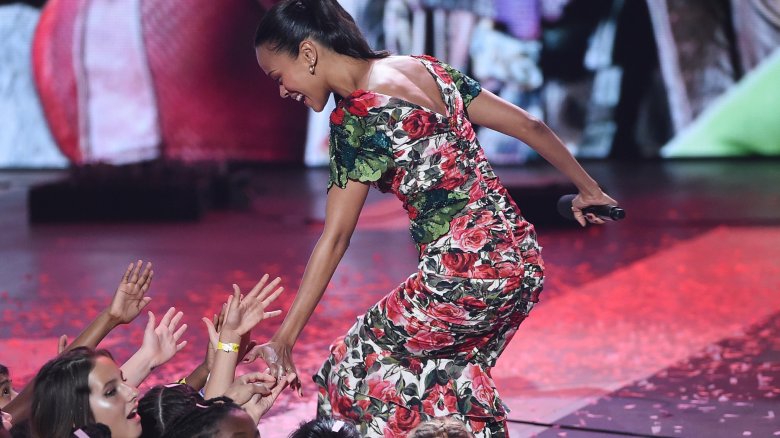The Untold Truth Of Gamora
Thanos' adopted daughter is the highlight of almost every Guardians of the Galaxy story she appears in, but if you only know Gamora from the Marvel Cinematic Universe, you're missing out. She's much more than a warrior, an orphan, a Guardian of the Galaxy, and a world-class assassin. She's a time traveler. She's a mother. A fashion icon. A lover. She's wielded one of the most powerful weapons ever made, seen her entire race get exterminated twice, gone toe-to-toe with some of Marvel's biggest villains, and conquered death itself — more than once, even.
Gamora's backstory is full of twist and turns that are crazy in all the best ways, and she's seen a fair amount of drama behind the scenes as well. There are a few very good reasons why Gamora is called "the most dangerous woman in the universe," after all. Gamora is many things, but predictable is not one of them.
Her comic book origin story is insane
In the MCU, Gamora's origin is pretty straightforward. As Guardians of the Galaxy reveals, Gamora's planet was wiped out by Thanos, who rescued her and raised her to be a warrior. She turned on Thanos, teamed up with Star-Lord, Rocket, Drax, and Groot — and the rest is history.
Simple, right? Just wait. In the comics, Gamora first appeared in Strange Tales #180, but we don't learn her history until Warlock #10. As the story goes, Thanos correctly predicted that the villainous Magus, a time-warped version of hero Adam Warlock and leader of the tyrannical Universal Church of Truth, threatened his plans for galactic domination. So, Thanos needed a weapon he could use to stop Magus before he grew too powerful. He found one — in the future.
Years after Warlock #10 takes place, Magus' soldiers killed Gamora's kinsfolk, the pacifist Zen Whoberis, as part of their crusade. Thanos, however, managed to rescue Gamora at the last minute, took her to the present, and trained her to stop Magus once and for all. Her assassination attempt fails (although she manages to kill the people responsible for the yet-to-occur Whoberis genocide, preventing it from taking place), but helps Adam Warlock beat Magus and the Church anyway.
The saga doesn't have a happy ending, though. In the current timeline, a hostile alien race, the Badoon, wiped out the Zen Whoberis anyway, while Gamora flat-out dies when she turns on Thanos. But more on that shortly...
The most important moment of her life happened off-screen
Like her origin story, Gamora's earliest days are pretty confusing. After two appearances in Strange Tales, her story moves into Warlock #9. That picks up the numbering from Adam Warlock's series, which was cancelled two years prior. Warlock ends a second time at #15, and the struggle between Thanos, Adam, and Gamora concludes in Avengers Annual #7 and Marvel Two-in-One Annual #2
As a result of all of this ping-ponging between different books, there's one big hole: while Gamora eventually learns about Thanos' true nature and betrays him, we never actually see it happen in full. In Warlock #15, Gamora leaves Thanos to hunt down Adam Warlock, but is attacked by Drax the Destroyer en route. When we see her next, she's dying, thanks to wounds inflicted by Thanos himself. We get a bare glimpse at her discovery in a three-panel flashback, but that's it.
So, what happened? Seeing Gamora betray her surrogate father should've been a real moment. Well, according to Jim Starlin, who wrote and drew Gamora's earliest adventures, that was the plan.
"That was supposed to be Warlock #16, which never happened," Starlin tells Newsarama. "I had a few pages penciled.... and then things fell apart with Marvel."
Allegedly, Starlin clashed with his editor, Gerry Conway, and Warlock was cancelled due to a combination of low sales and — believe it or not – a paper shortage. When Starlin returned to Marvel, he had limited pages to wrap everything up — and so, supporting characters like Gamora got the short end of the stick.
She's died. A lot.
Gamora might be the self-proclaimed "deadliest woman in the galaxy," but that hasn't stopped her from kicking the bucket on a handful of occasions. Don't worry: she always seems to get better.
When Gamora was a child, Thanos took her to the planet Tartoonla #7. Wanting to prove her fighting skills, Gamora disobeyed Thanos' orders and started exploring the spaceport — a fatal mistake. As revealed in Warlock and the Infinity Watch #9, a trip down the wrong alleyway ended with Gamora getting beaten to death by a roving street gang, leaving Thanos to rebuild her body from artificial parts. As a result, Gamora has super strength and speed, but can no longer cry. You see, Thanos redirected her tear ducts.
That's the beginning of a trend. As previously mentioned, Gamora dies again in Avengers Annual #7 after telling Warlock about Thanos' plan to destroy, well, everything. While her body perishes, however, her spirit — along with Warlock's and Pip the Troll's — ends up safely ensconced inside the Soul Gem, one of the Infinity Stones. She returns to life in Infinity Gauntlet #1, published about 14 years later, but there's a catch: her soul is put into the corpse of a woman named Bambi Long. Even when Gamora is alive, she's still technically dead.
When Thanos uses the Infinity Gauntlet to end half of the life in the universe, Gamora bites it again, although Nebula resurrects her and everyone else. In Guardians of the Galaxy #19, Magus returns and kills Gamora again, only to resurrect her while trying to convert her to the Universal Church of Truth via torture. Naturally, it doesn't stick.
She carried one of the Infinity Gems
So far, the MCU has been all about the Infinity Stones, six brightly colored and infinitely powerful rocks that act as the MacGuffins for the entire MCU. The Red Skull used one to fuel his superweapons. Loki's scepter held the Mind Stone, which the villain used to brainwash Hawkeye, and which later ended up bringing the Vision to life. The Reality Stone pops up in Thor: The Dark World, the Time Stone plays a crucial role in Doctor Strange, and the Power Stone is the thing that drives the action in Guardians of the Galaxy.
The Infinity Gems have comic book counterparts, of course, although on the printed page they're better known as the Soul or Infinity Gems. They've been around since 1972, and they play a big role in Infinity Gauntlet, which is a foundation for Avengers: Infinity War. It's not just Thanos that's wielded the gems, however. After Infinity Gauntlet, Adam Warlock took control of the Infinity Gems, but higher powers than him decided that it was too much power for one person to handle, and distributed the gems among some of Marvel's cosmic heroes, including Gamora.
As part of the superteam known as Infinity Watch, Gamora was entrusted with guarding the Time Gem (her future Guardians teammate, Drax, was in charge of the Power Gem, too). Now, Gamora didn't actually know how to use the Time Gem, although she'd occasionally get prophetic visions thanks to the gem's influence, and she eventually gave up her duties and left the Watch. The gems were stolen and Infinity Watch disbanded shortly thereafter.
She has an (adopted) daughter
If you've been paying attention, you might've noticed that Adam Warlock plays a big part in Gamora's pre-Guardians life. Given the laws of comic book relationships, that means that they'll inevitably hook up. Warlock and Gamora didn't just become a couple, however — they actually have a child together, albeit an adopted one.
In Infinity Abyss, Jim Starlin's 2002 entry in his long-running "Infinity Saga," five clones of Thanos called the Thanosi set out to kill Thanos and destroy the universe. Naturally, Warlock, Gamora, and their friends try to stop them. The key to the Thanosi's scheme is an all-powerful being called Atlez, who has served as the "anchor of reality" since the Roman Empire reigned supreme. Atlez isn't the first creature to bear that mantle, of course: anchors psychically pass their knowledge on to their successors, and Atlez decides to use Warlock to get his "tutorial" to Atleza, the next-in-line, when he realizes his time is running out.
There's just one problem: Atleza is still a little girl. Gamora and her buddies end up defeating the Thanosi, but Atleza, who's kinda overwhelmed with her newfound cosmic powers, needs training. As such, Gamora and Warlock retire to a pocket dimension to teach her the ways of the universe while also serving as her foster parents. It's one of the weirdest families imaginable, but for Warlock and Gamora, weird is an everyday thing. With the two of them at her side, Atleza should be just fine.
She hooked up with Iron Man
On the big screen, Gamora might be the Shelley Long to Star-Lord's Ted Danson, but in the comics, they're not really a thing at all. Not only does Star-Lord have his own complicated love life, which includes a failed betrothal to the X-Men's Kitty Pryde, but Gamora's been too busy dating some of the heaviest hitters in the Marvel Universe to give the lead Galaxy Guardian a second thought.
When we say heavy hitters, we mean it, too: in Guardians of the Galaxy #4, Gamora and Iron Man end up in bed together after a night at the bar. And if you think this is another example of that rascal Tony Stark working his charms, think again. Gamora's in the driver's seat the entire time. Not only does she call Stark out on his BS, but after their brief fling, Stark winces with pain. Gamora, on the other hand, walks away just fine.
Iron Man isn't Gamora's only paramour, of course. As previously mentioned, she had a lengthy on-again off-again relationship with Adam Warlock. More recently, she's also had a long-term relationship with space cop Richard Rider of the Nova Corps, although that romance came to a sudden end in Guardians of the Galaxy #20, when Rider sacrificed himself to save his fellow Guardians from the Cancerverse. Suffice it to say, when he came back to life, things got pretty awkward.
Zoe Saldana learned about Gamora from her sister
Zoe Saldana is a self-proclaimed geek, and she's got the bona fides to back it up. Not only did she make her name by appearing in genre fare like Pirates of the Caribbean, Avatar, the JJ Abrams Star Trek revival, but she grew up watching Terminator, Aliens, Dune, and Luc Besson action flicks. She read and watched so much sci-fi as a kid that she says, "It was odd for me to grow up and go out in the world and not see other women going crazy for science fiction."
Yet, Saldana didn't really read comics as a kid. And even among the Guardians of the Galaxy's cast of B-list heroes Gamora was remarkably obscure. It's no surprise Saldana had to learn about Gamora from an outside source. When Saldana first got the call about the character, she hadn't heard of either the green-skinned assassin or the Guardians' comic itself. "My sister was the one who told me about it," she explained in a 2013 interview with the UK's Absolute Radio.
Still, Saldana signed on based on the strength of James Gunn's script, and it quickly became clear she was the right actress for the role. When it came time to rehearse the big showdown between Gamora and Nebula, Saldana showed up on set fully prepared, thanks to her history with both ballet and stunt-work.
"She barely required any rehearsal," Karen Gillan, who played Nebula, told MTV. By contrast, Gillan said, "I required two months of rehearsals every day that I wasn't shooting, because I looked like spaghetti when I started."
In the movies, Gamora was almost a different color
Good news, cosplayers: no matter what kind of clothing you like, Gamora's got you covered. Want something retro? When she first debuted (and whenever Jim Starlin draws her, it seems) Gamora sported a netted outfit with exposed abs, a healthy dose of side-boob, and lots of skulls. Prefer the space-barbarian look? During the Annihilation event, Gamora switched to a revealing, fabric-light ensemble that made her look like a Vampirella knock-off. That was followed by a battle-ready leotard, heavy space armor, a gothy flowing cloak and spandex combo, a movie-inspired leather get-up, and, finally, some sporty activewear with plenty of padding.
While Gamora has sported all kinds of outfits, however, there's always one constant: she's always green. That, more than anything else, is her signature look. And yet, as Guardians of the Galaxy's concept art proves, even that's not a given. In fact, when Guardians was in pre-production, Gamora was blue.
In some ways, the off-color design by Marvel Studios artist Andy Park hews closer to Gamora's comic book look than the final product. On the printed page, Gamora often has big gold, red, or green circles around her eyes, which Park reinterpreted as a kind of goopy, bluish battle paint. All in all, it's pretty darn cool. Someone at Marvel must've realized that Gamora's unique hue was her signature, however, because Park notes that, at some point, Gamora "had to be green." That, as they say, was that.
She was missing from Guardians of the Galaxy merchandise
The first Guardians of the Galaxy wasn't just a hit with comic fans. It was a hit with everyone. When Guardians hit theaters, reports say that its audience was 44% female — a major increase from previous Marvel movies — and industry observers say characters like Gamora and Nebula had a lot to do with that.
Newly-minted Gamora admirers who wanted to proclaim their fandom with their wallets, however, ended up disappointed. While Gamora is a key team-member, she was hard to find on the film's tie-in merch. Guardians of the Galaxy t-shirts and backpacks left Gamora on the sidelines. Her action figures were hard to find, or relegated to specific retail outlets.
Fans were so unhappy that they started a hashtag, #WheresGamora, that attracted national attention. They weren't the only ones. Guardians of the Galaxy director James Gunn weighed in on the situation, and he wasn't pleased. "It's frustrating when she's not in stuff," Gunn said, "and so it bums me out." Marvel Studios president Kevin Feige agreed: "I think the outrage was great, because that's not going to happen anymore."
And it didn't. Gunn took a personal interest in the merchandising efforts for Guardians of the Galaxy 2 and made sure Gamora, Nebula, Mantis, and the rest of the film's female cast were well-represented.
Gamora has made Zoe Saldana a better parent
Zoe Saldana isn't just a gifted actor and kickass action star. She's also a mother, with a pair of twins and a third son named Zen. Balancing parenting with her Hollywood career takes some effort. Thankfully, Saldana and her husband seem to have things under control, thanks to a little help from Gamora. Wait, what?
Saldana's kids are still pretty small, but they already have a firm grasp on the ins and outs of the MCU. Not only do they love to play with their mother's Gamora figures — "They break her," Saldana notes — but the children have noticed their mom's MCU character shares a skin tone with one of Marvel's biggest and baddest heroes.
"Green, Gamora, Hulk?" Saldana said to E!. So now Saldana's twins think she has a special connection to the jade giant, and the actress uses that to her advantage. If the kids don't eat their vegetables, Saldana says the Hulk is going to come and get them — or, at the very least, take away their toys.
More seriously, Saldana also says Gamora and her sci-fi heavy career has helped her become more empathetic. After all, science fiction is filled with outsiders, and Saldana thinks it's important to tell stories about "feeling like an outcast, like you don't belong, trying to find friends that you can fit in, things like that." Saldana says, "Every time I rip myself away from my children, it hurts so much and it hurts them... so the least I can do is make sure that whatever it is I'm doing is rewarding."
